#Runic Alphabet
Explore tagged Tumblr posts
Text

A stirring of mental activity will begin today as you birth new ideas on how you are going to implement a new hands-on opportunity. Immediate action will need to be applied. Not by sitting around talking but by making sure the discussion is recorded so these creative ideas will not be forgotten. There is an added benefit coming today. Those recordings will further inspire improvement in the ideas that have already been spoken.
#elder futhark runes#runes#rune divination#rune reader#rune reading#runic alphabet#futhark runes#nordic runes#divination#fortune telling#fortune teller#message for the collective#gay pagan
57 notes
·
View notes
Text
understanding norse runes: a historical and modern perspective pt. 3
Sorry it's taken me so long everyone, holidays and school starting back up had me really distracted.
For part 1 click here, for part 2 click here.

ᛏ tiwaz
ANGLO-SAXON:
"Tir is a guiding star, well keeps faith with princes; it is on course over the mists of night, never failing."
NORWEGIAN:
"Tiw is the one-handed member of the Aesir often has the smith to blow."
ICELANDIC:
"Tyr is the one-handed As and leavings of the wolf and king of temples."
INTERPRETATION: Law and order, justice, victory, but victory for the people, not just the individual. Tyr (this rune's namesake), as the god of war, is also a god of the people, much in the same way Ares is. This rune emphasizes self-sacrifice in the name of common good, in order the serve a larger purpose. However, Tyr also embodies the wisdom of the goddess Athena, also a goddess of war. You have to be reliable, hard working, and loyal in order to achieve success, but you also have to have a plan, gather intel, do research. Think about what you did to deserve your successes: it's not just about the end goal, but the path you took too. As a bindrune, this stave can be good for summoning courage and energy needed for change, especially in legal matters. However, if your motivations are not pure, or actions not just, Tyr will just as much take action against you as for you. Use this rune if you need help bolstering your leadership skills, or for reinforcing a position you already have. Take decisive action, assert yourself, and take on obstacles with gusto.
KEY WORDS: Courage, loyalty, justice, wisdom, determination
ASSOCIATIONS: Tyr
ᛒ berkano
ANGLO-SAXON:
"Poplar/Birch bears no fruit, bears without seed suckers, for from its leaves it's generated, splendid are its branches, gloriously adorned its lofty crown, lifting to the sky."
NORWEGIAN:
"Birch is the greenest-leaved of branches; Loki was lucky in his deception."
ICELANDIC:
"Birch is leafy branch and little tree and youthful wood"
INTERPRETATION: Meaning "birch," this rune represents birth and rebirth, especially when created out of very little. New beginnings, or a restart of something old. But just in as much as it can be ascribed to the cycle of life, this rune is also connected to the cycle of death, as they go hand-in-hand. Birch is a hardy tree that grows in cold climates, bracing the bitterest winters to be cut down and used for maypoles at the coming of spring. This stave is especially useful in what is called "feminine" magic: relating to menstruation, birth, protection of young girls, or sensuality. Use Berkano to call upon the power of Frigg during wedding preparations, Freyja during times of courtship, and Hella during times requiring vengeance or after betrayal. Prosperity and beauty are indicated, as well as a nurturing, protective force. Lots of interpretations relate this rune to the Divine Feminine, or the Goddess archetype.
KEY WORDS: Fertility, new beginnings, femininity,
ASSOCIATIONS: Frigg, Freyja, Hella
ᛖ ehwaz
ANGLO-SAXON:
"Horse is a joy to princes in presence of earls, Horse in pride of its hooves, when rich men, mounted, bandy words, and is to the restless ever a comfort."
INTERPRETATION: Relationships and friendship, literally meaning "horse," the interpretation stems from the trust and love between rider and horse. On any journey into the unknown, you should always bring a friend. Mutual trust is important, though, and that takes a good amount of work to achieve. Harmony between to people is indicated, but loss of individuality does not accompany it. Reliability and loyalty are important qualities in this situation, not intolerance or jadedness. This harmony can also be achieved between two unlike things, two opposites: man and woman, physical and psychic, shaman and god. It is a good rune for meditation with the gods, as it can help bridge the gap between the mortal and immortal realms. Because ehwaz means "horse" this rune can also indicate travel or change. A steady and progressive change is underway, and consistency is key to maintain it.
KEY WORDS: Partnership, harmony, travel
ASSOCIATIONS: Sleipnir, Freyr
ᛗ mannaz
ANGLO-SAXON:
"The mirthful man is dear to kinsmen, yet every man must fail his fellow since the will of the Lord dooms that the frail flesh to earth be taken."
NORWEGIAN:
"Man is an augmentation of the dust; great is the claw of the hawk."
ICELANDIC:
"Man is the joy of man and augmentation of the dust and adorner of ships."
INTERPRETATION: Literally meaning "man," mannaz represents the journey towards self-actualization, achieving an internal balance: between mortal and divine, between male and female, between conscious and unconscious. Take responsibility for yourself, and have respect for everything around you: nature, your fellow man, the gods, our ancestors, and your future. This is the stave of humanity, and all the flaws and follies that may accompany it, but recognizing them as inherently Human, and therefore not all that negative. It represents an awakening, like removing the blinders from a horse, so to speak. It addresses question of identity and purpose, one's function in society. However, this rune requires cooperation, for the user not to fight their "destiny" (which is self-made), or to at least not to abandon it. This rune represents the choices a person is constantly presented with, the same choices everyone is presented with, as a collective. It serves as a reminder that we are never alone, and while we are constantly reliant on others, we should also allow others to be reliant on us.
KEY WORDS: Identity, self-actualization, community, humanity
ASSOCIATIONS: Heimdall, Odin-Vili-Ve
ᛚ laguz
ANGLO-SAXON:
"The sea seems interminable to people if they shall venture on rolling ship and the waves of the sea terrify them, and the sea-stallion heeds not its bridle."
NORWEGIAN:
"Water is where a cascade falls from a mountain-side but ornaments are made of gold."
ICELANDIC:
"Water is welling stream and broad kettle and land of the fish."
INTERPRETATION: With the translation being "lake," the laguz rune represents a lot of what the element of water represents: creativity, visions/dreams, emotions, and vital energy (coming from the idea of the Niflheimr). As with the flow of a rushing river, it is safer to go along with the current than to fight it. A period of trials leading to personal growth is indicated, something that will be difficult, but not outright impossible to overcome. It may be that something hidden is soon revealed. You might feel overwhelmed, or quite put upon, but remember that there is nothing wrong with you, and all shall soon come to pass. Representing the essence of life, laguz can have alternative meanings involving birth, reproduction, healing, psychic powers. It's usage in matters involving the female reproductive and menstrual cycle is said to be very powerful.
KEY WORDS: Intuition, femininity, adaptability, emotional depth
ASSOCIATIONS: Nerthus
ᛝ ingwaz
ANGLO-SAXON:
"Ing was first among the East-Danes seen by men, till he to the east over waves went, his wain after ran, thus the Heardings named the hero."
INTERPRETATION: Ingwaz, representing fertility and masculinity, was said to translate to "Yngvi," thought to be another name for Freyr. It is the time before actualization, a period of gestation, in a sense. This is a potent state, a time where you have to have patience, and let things come to be on their own time. Ingwaz is a rune of transformation, of birth and death, of sensuality and love. However, not so much in the same way that Freyja was a goddess of love, but in the way that Freyr could be interpreted as a god of love; which is more about virility and sex than love. However, if your issue does not relate to interpersonal relationships, this is definitely a rune of nature. This is the stave of the farmer, of the father. Look towards the masculine figure in your life for answers, whether they will provide it to you, or are the crux of your issues.
KEY WORDS: Virility, fertility, potential, masculinity,
ASSOCIATIONS: Freyr
ᛞ dagaz
ANGLO-SAXON:
"Day is God's sending, dear to men the great lord's light means mirth and happiness to rich and poor, useful to all."
INTERPRETATION: Meaning "day," this rune represents clarity, awakening, opening the third eye, consciousness, hope and happiness. Often given very little context other than it's interpretation being overall positive, the dagaz rune should be invoked whenever you need a turning point, or clarification. It is the light of day at dawn, that brings recompense to the fearful and retribution against the hateful. It reminds of the cyclical nature of life, as bad times come, so does new hope emerge. New opportunities are being presented to you, basically on a silver platter. When surrounded by other runes, it turns basically a whole reading towards the positive.
KEY WORDS: Awareness, dawn, hope, happiness
ASSOCIATIONS: Day, Odin
ᛟ othala
ANGLO-SAXON:
"An estate is very dear to every man if he may there rightly and peacefully enjoy in the hall frequent harvest."
INTERPRETATION: The rune of the hearth and home, othala means, most literally "ancestral property," which aligns very similarly to the divinatory interpretation. It promises safety and stability, our relatives, our roots. However, it also warns us to not hide behind our pasts, and to be constantly evolving along with the rest of society. At the end of the day, we must always have something to come home to, a strong foundation. But if this foundation is unsteady, like a toxic relationship is, it can harm us more than help us. It represents everything inherited, psychological traits, land, a home, a name, family, a community. It represents the separation between the here and now, and the then and there, between mortal and immortal. For this reason, it can be a rune to represent Odin.
KEY WORDS: Heritage, inheritance, legacy, tradition
ASSOCIATIONS: Odin
#pagan#paganism#polytheist#polytheism#witchblr#witchcraft#witch#magic#magick#divination#norse pantheon#norse gods#nordic mythology#norse mythology#nordic#norse runes#runes#norse polytheism#pagan witch#paganblr#pagan community#runic magic#runic alphabet#norse heathen#heathen#mental heath support#heathenry#norse paganism#norse pagan
120 notes
·
View notes
Text
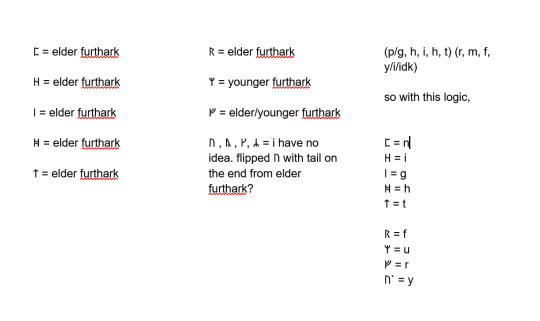
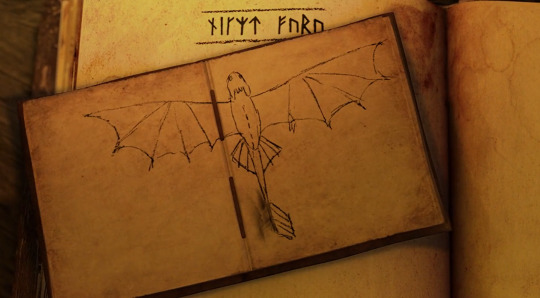
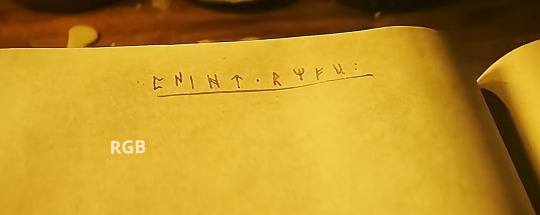
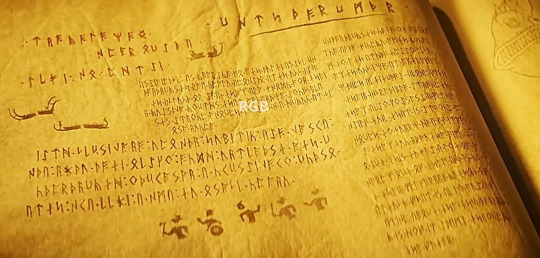
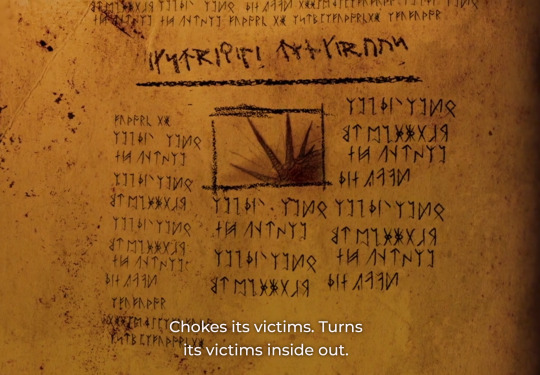
Anyone else able to figure out what language mesh they decided to use for the live action? It's different from the movie and the books. I'm aware httyd has some crazy inconsistencies in the languages they use for like. everything. so I'm not surprised it's different, but now I'm interested in decoding/understanding it. I especially can't figure out what the last character is for the live action... i have literally no idea about runes whatsoever except for some wikipedia searches but it looks like an upside down ᚢ with a tail on the end of it... lol
anyone have any insight/are more informed about the weird berkian alphabet who could help me?
#httyd#httyd runes#how to train your dragon#runic alphabet#httyd alphabet#what the helly is going on here. i cant figure it out#didn't they have a.... movie they could use? why did they make a whole new alphabet lol
7 notes
·
View notes
Text
The Runes - An Introduction
Hello! Today, we're going to be looking at the runes. This is the introductory post for our rune study, which will be an in-depth look at each rune individually.
Before we get to that, we need a little history and background, so this is an introduction. There will not be any divinitory meanings explored today. We are simply looking at the runes and learning about their history.
Different Runic Alphabets
Many heathens are aware of two runic alphabets, Elder Futhark and Younger Furhark. However, there are more runic alphabets than just those. Some other alphabets are the Germanic Futhork and Medieval runes. While there are many runic alphabets, this blog will primarily explore the Futharks.
Elder and Younger Futhark History
As one might guess, the Elder Futhark gets its name because it came before the Younger Futhark. I have found some discrepancies over when Elder Futhark first appeared. That being said, somewhere in the 1st or 2nd century, Elder Futhark began being used by the Norse people.
By the Viking age, so around the 8th century, Elder Futhark turned into a different, shorter, alphabet that we now know as Younger Futhark.
Differences in Elder vs Younger
As stated before, Younger Futhark is much shorter. In fact, Younger Futhark is only 16 letters long. This is much shorter than Elder Futhark's 24 runes.
Another difference is that Younger Futhark has 2 different versions. They are often called Short-Twig and Long-Twig. Both of these versions mean the same thing. It's kind of like modern-day cursive versus print handwriting.
Were the Runes Just Alphabets?
This is a hard question for us to be 100% sure on. We have had some sources and people tell us that the ancient people did not believe the runes to have a deeper meaning than being characters in a writing system.
However, this is slightly contradictory with the mythological story we have about the runes (more on that below).
It is possible that they believed the runes held a deeper meaning, but did not use them for divination as we do today.
Odin and the Runes
In Norse mythology, Odin "discovered" the runes while he hung from the world tree, Yggdrasil, for nine days and nights after he impaled his heart with his own spear. It's said that the runes came to him from the Well of Urd, which is the source of fate.
Many people say that Odin put himself through this dangerous event because he knew the runes held great meaning and wisdom.
In Conclusion
The Elder and Younger Futhark are very interesting pieces of history and of the heathen path. I hope this post helped explain their history and background. I'm excited to start our in-depth study of the runes! We will start with Elder Futhark and then move to Younger Futhark. Below, you'll find quick charts of what the different Futharks look like!
#norse pagan#pagan#pagan witch#paganism#witch#witchcraft#norse heathen#heathenry#heathen#norse runes#runes#runic alphabet#elder futhark#younger futhark#rune study#study the runes
10 notes
·
View notes
Text
MASTER SORCERY COURSE
As the name suggests this is the course to master in runic and icelandic methods
I love combining them, the above video is a glimpse done by my student to show you all how we work with herbs to make them powerful and unleash their magic and potency. Like this you will learn much more techniques to be powerful in your spells and to get maximum results for you and your clients.
Contents
What are staves ?
Staves and how to.work with them
Runic and icelandic combination
How to invoke and evoke
How to destroy the staves after use
Connect to spirits with staves
Spell casting
Ways of working with icelandic and runic magick
Connect with Icelandic ancestor ways
Difference between Norse runes and Icelandic
Different ways of using staves
Around ten spells will be covered and some powerful prayers
Book your seats now.. whatsapp to 9176231990
2 notes
·
View notes
Text

You will be criticised about you lack of progress with your goals today. Your inaction has been put on notice by those who hold a high expectation of your self-worth and your ability in making a difference to the very critics that surround you. Accepting or even requesting support will be ignored. It is almost as if today you are celebrating your stubbornness in doing nothing. It is one of those small pleasures you need to take full advantage of today.
#Runes#elder futhark runes#elder futhark#nordic runes#runic alphabet#runic divination#rune divination#rune reader#rune reading#divination#fortune telling#fortune teller#message for the collective#gay pagan
27 notes
·
View notes
Text
This is fascinating and super helpful! I've wondered about this too for a while.
I hope you don't mind but I also have a question about the runes used in this scene in HTTYD2 (shown below).
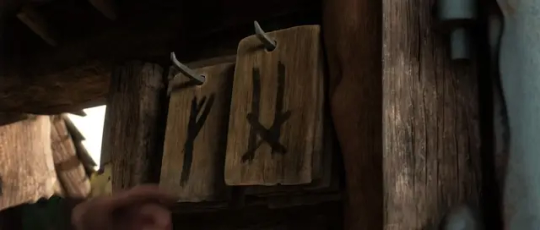
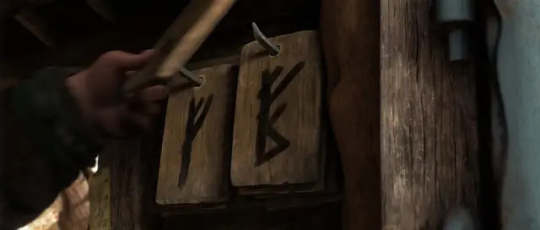
Presumably they're numbers since Stoick thereafter calls "41!" to the person waiting in the queue for their number to be called. But as far as I have been able to tell, there isn't a precedent for numbers in the runic alphabet, but I found your post and thought I'd defer to what info you've collected on the subject! 😅
Kay's Guide to Runic Writing in HTTYD
Hi! Welcome to my slapped together guide to reading text in HTTYD.
The main section of legible text in the Book of Dragons and other written materials in the HTTYD movies uses a simplified form of Younger Futhark.
What is Younger Futhark?
Younger Futhark is a simplified and evolved form of Elder Futhark. YF appeared around the 9th century, and corresponded with the Viking Age. I've included the Runes source in a link with the first image if you wanna explore it for yourself.
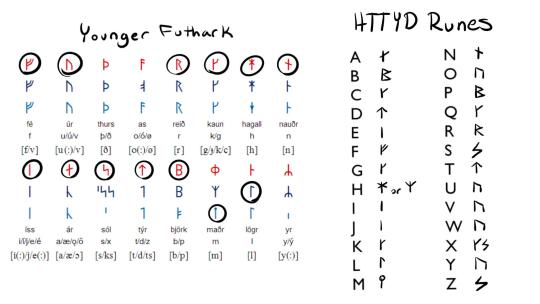
The top row of runes (red) are specifically the Danish version of YF. The middle and bottom rows are Norwegian and Swedish. I've shown the HTTYD specific runes so you can see the changes made, which is mostly just using the same runes for multiple letters since they needed all 26. All the legible writing in the HTTYD movies are transliterated English, just using the runes instead of our known alphabet. This makes it pretty easy to learn to read and write it with a guide or some good memorization.
The letters M and L use the Swedish/Norwegian version of the runes. Why? I don't know. They also use ür for 5 different letters so I'm not questioning it.
If you see on the HTTYD runes list, there are two written for the letter H. As far as I've been able to see, the only time the second one has been used is for Night Fury in the Book of Dragons. I've assumes this is for stylistic choices, as it is not a H rune in any of the source lists used.
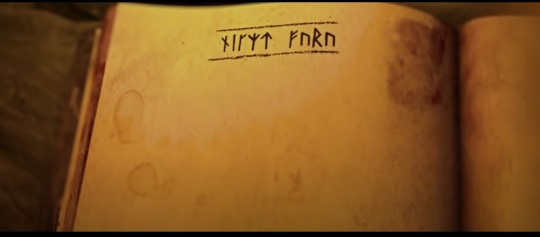
Below, we can see an example of the complex H rune in the name Thunderdrum. Its actually written Thunderdum here, and I'm assuming that since the handwriting is bad, that the character who wrote it spelled it wrong.
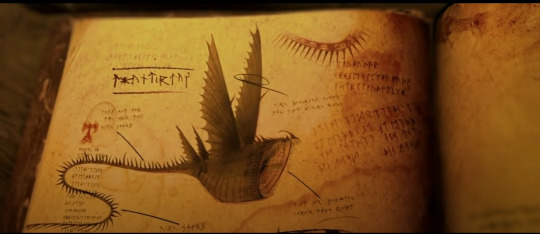
While I do believe that was simply spelled wrong, there are other places where a CK is combod as just a K like below in the Timberjack title.
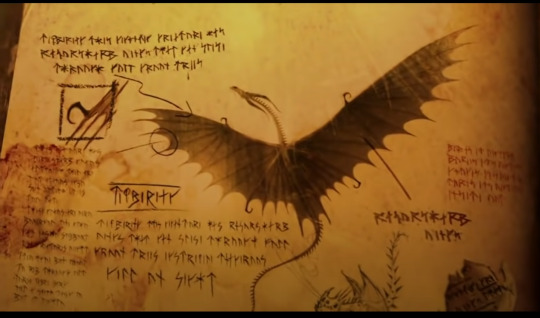
While some of the text in these pages is legible, there are side/background paragraphs that, to my knowledge, are not. These side paragraphs appear to be written in Elder Futhark, or a version thereof, and are not written normally. Some paragraphs are backwards, and flipped runes, repeating 'words', and symbols i cant identify at all.
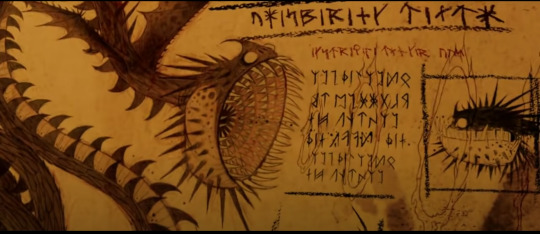
Take a look at this paragraph on the Whispering death. Using the Elder Futhark list, the first line reads zpl(th)izpdo. The only thing I can fathom this referencing is the word Zippleback but ehhhh. Its also flipped horizontally, as all of those runes are backwards. Granted, I can't actually read Old Norse, but some of the runes on the second line I can't find any reference to.
You should absolutely take all of this with knowing that I am most definitely not an expert in any of this, this is just a special interest I decided to finally write up on after first getting it together four years ago lol.
*If there is any additional information I find or put together, I will update this post with edit date timestamps*
Enjoy and write!
230 notes
·
View notes
Text
Fascinating thing I noted in the falconreach libraseum: we see languages other than english/common being used in books on a couple different occasions. It seems that Dwarves speak Scots (or at least a bastardized "an American wrote this" version of it). The mysterious Shaking Kings, from south of the Kaer, supposedly sang in Latin. Gaeilge is used in the story of The Smallest Dragonrider, which is set near, and thus presumably also written around, Stoneheart Fall- it may be local to the area, or used by moglins whom the story is about, or from somewhere/someone else entirely.
I just think that's neat. There's clearly a common language across Lore, since we're able to easily communicate with Azaveyrians and Le'shyians- but while that does serve as a useful way to keep plot rolling, I always felt it would be nice to see some languages from around the world.
#dragonfable#late nights with ali#ali plays ae#there's also of course the frost giants writing in norse runic in book 2. though it's still technically in common just a different alphabet#anyway. niche bits of workdbuilding my beloved
26 notes
·
View notes
Note
I refer to you as rússneska which is the Icelandic adjective for Russian. It’s also just a cute word
vocabulary updated
#icelandic wooooooo !!!!!#just googled it RUNIC ALPHABET?????#DREAM. THIS IS MY DREAM#wait we have glagolitsa too but it doesnt look really runjc and i dont know it anyway#damn it looks Badass. but java first#славяне ! ученые обнаружили происхождение слова русня !!
4 notes
·
View notes
Text
Now available in both paperback and digital formats from Barnes and Noble's website
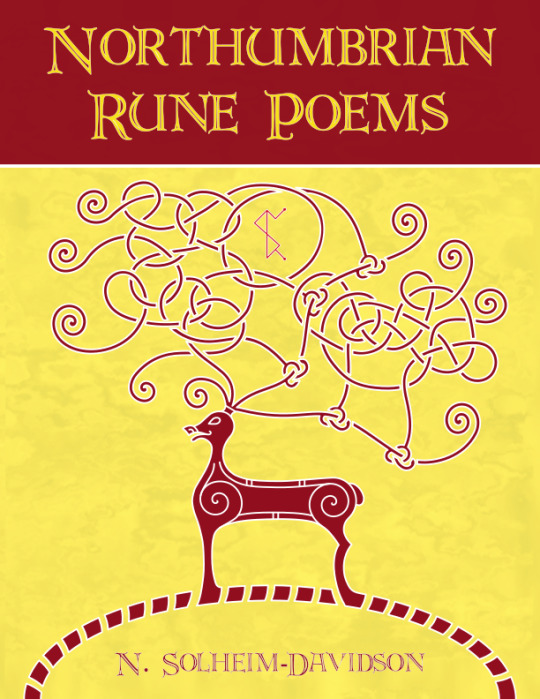
Northumbrian Rune Poems is now officially available for purchase. Digital and physical copies available here.
Inspired by the Old English Rune Poem, Northumbrian Rune Poems centres its focus on the Early Medieval English Futhorc runerows with additional attention paid to the four runes that were in use in Northumrbia. Mixing free verse poetry with kennings found within Old Norse and Old English poetry, Northumbrian Rune Poems is a magical read that breathes new life into an otherwise neglected runerow. Alongside each poem is an Old English adaptation written in a Northumbrian dialect using Old English alliterative style to capture the spirit of the poems in a new light.
#north sea poet#heathenry#poetry#my poetry#nico solheim-davidson#heathen#runes#futhorc#Northumbria#Heathen Poet#Heathen Poetry#north sea rune poems#northumbrian futhorc#anglo-saxon futhorc#anglo-frisian futhorc#rune poems#old english#anglo saxon#futhorc runes#runic#runic alphabet
89 notes
·
View notes
Text
hey does anyone know if there's a way to put text in columns on ao3...
#what if. parallel text in roman and runic alphabets. hmm#there is a basic left/right alignment thing but you need to use line breaks so everything ends up reeeally spaced out and awkward#ao3#ao3 formatting
0 notes
Text
Okay so like weird pet peeve about fantasy RPG worldbuilding of mine is writers who treat "Runes" as, like, a special class of writing systems instead of. Basically a variant of an alphabet. I'm reading Halls of Arden Vul (bought it) and it is very good and expansive but reading about the languages and writing systems of the world I'm just struck by the fact that the author seems to be implying that the various "runic" writing systems are logographic or ideographic and I'm just. No. Runes were just an alphabet.
596 notes
·
View notes
Text
Sigil Magick: Illustrating Your Intent
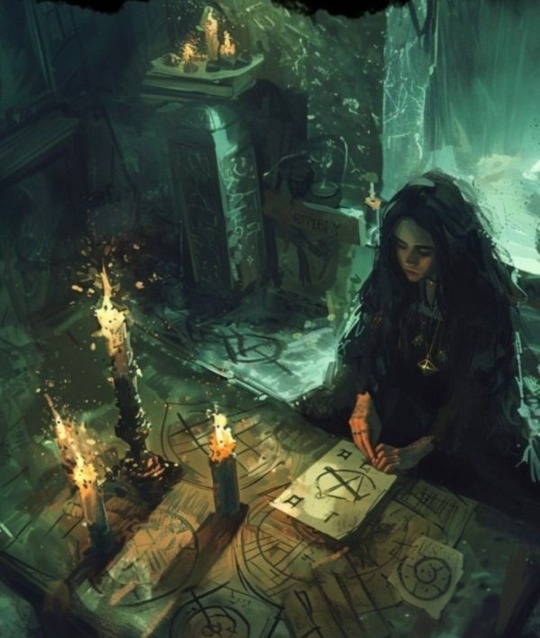
Sigils are a cornerstone of contemporary and chaos magick and function as keys to unlock the doors of reality and bend it to one’s will. These potent symbols serve as physical embodiments of one’s intentions, cast into existence through the fusion of art and willpower.
The crafting of a sigil begins with a clear and focused intention, which is then worked into a unique symbol through a creative magickal process. The magick practitioner inscribes deep personal meaning and style into their designs, making each unique to its artist. Sigils are ideal tools for manifesting your desires, imbuing objects with specific purpose and energy, protecting spaces, and communicating with the spirit world and should be used responsibly.
Origins
The practice of crafting sigils traces its roots to the ancient world but was modernized in the early 20th century by the works of Austin Osman Spare, an occultist and artist. He introduced the method of creating magical symbols by condensing letters of a desire into an abstract design. Aleister Crowley, too, influenced the practice by intertwining sigils with ceremonial magick, embedding them with a rich esoteric significance.
Some occult grimoires employ sigils as a means of contacting spirits, for example; Ars Goetia, The Book of Oberon, and Pseudomonarchia Daemonum.
Basics of Sigil Magick
Sigil magick emerges from the belief in one’s ability to manifest their focus into reality. Through a process of creation, a sigil becomes much more than mere ink on paper—it is the illustrated essence of desire. Individuals can use sigils as focal points for their will, empowering these symbols through meditation or ritual to enact change. The universe of sigils is vast and varied, types of sigils include:
• Pictorial Sigils: Intuitive symbols drawn from the subconscious
• Runic Sigils: Combinations of runic alphabets that resonate with specific energies
• Word Sigils: Derived from statements of intention, where letters are crafted into a unique symbol
Correspondences also serve a purpose in this class of magick, in order to help align one's intent to universal energies. As an artist crafts their sigil, they intertwine traditional symbols with personal significance, creating a bridge to the metaphysical world. Some relevant correspondences are:
• Numerology: Numbers carry vibrations that can enhance a sigil’s purpose.
• Zodiac Signs: Celestial influences infused to fine-tune the focus.
• Elements: The classic forces of Earth, Air, Fire, and Water lend their power to sigils, grounding them in natural harmony.
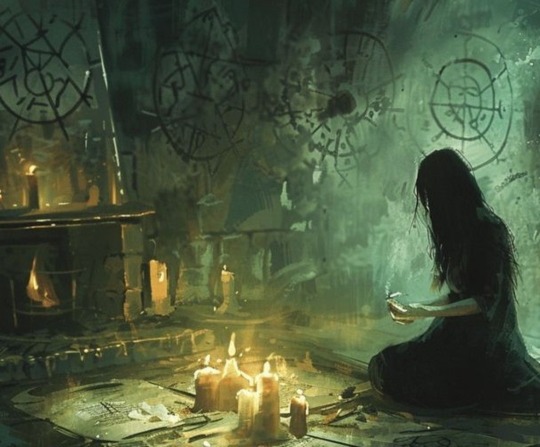
Sigil Creation
Before you take pen to paper, first envision your intent with clarity and purpose This may involve some deep introspection into the true nature of your desires. A precise intention lays the foundation for the sigil's power. Once ready, write out your intention and cross out any duplicate letters. From here a couple different methods can be utilized. Naturally you could always draw your sigils from pure instinct, creating spontaneous shapes to represent your intentions, but there are other techniques available.
The Wheel
This method employs a wheel to be used as a map for drawing your sigil. Simply start at the first letter of your intent and draw lines to each subsequent letter. Example:
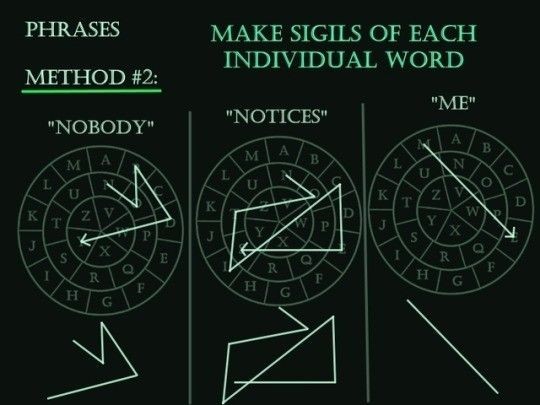
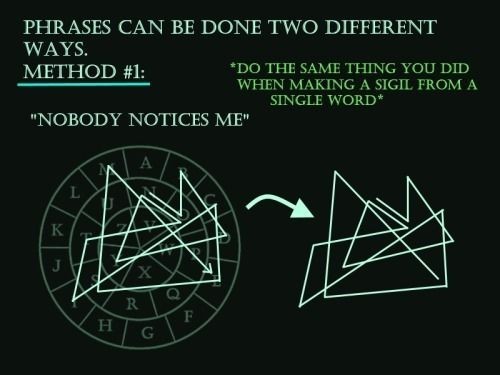
My Method
I make my sigils by breaking up the letters to create shapes. I will often decorate with extra shapes, symbols, and pictures as well. Here is a simplified example of my sigil creation process:
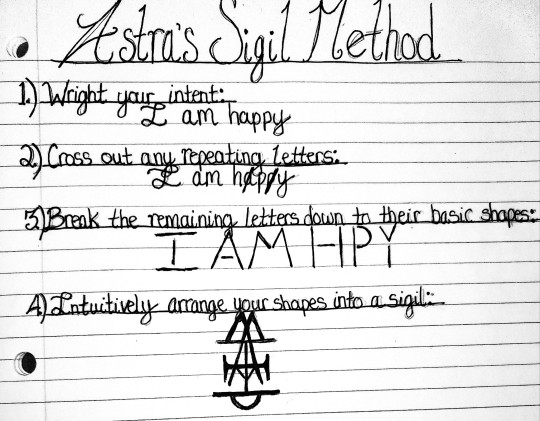
Next you must charge your sigil. Charging is the act of infusing the sigil with energy. The creator might enter a meditative state, focusing intently on the sigil while envisioning their intentions intertwining with the design. This act of focused concentration serves to embed the intention within the sigil, making it a beacon for the desired change.
Passive and Active Sigils
Intentioned sigils fall into either the passive or active sigil category based on how that sigil's energy is best utilized. Passive sigils are usually drawn on the body, item, or surface and then left alone to release their power over time. Active sigils involve some action to trigger the release of the sigil's energy, such as burning, burying, soaking with water/oil, and more. Some sigils can be used both passively and actively, but most will fall into one category.
Spirit Sigils
Many spirits and deities have sigils that represent them and these can be powerful catalysts for interacting with these beings. If the spirit you're working with doesn't have a sigil made for them (or even if they do) you can design your own symbol to connect with that spirit. Follow the same process, but instead of focusing on your intent, focus on the spirit/deity and connecting with it. You can even perform a ritual and provide an offering to invite the spirit into your space. This will allow you to draw divine inspiration straight from the source. Here are some examples of spirit/deity sigils, as well as some I created:
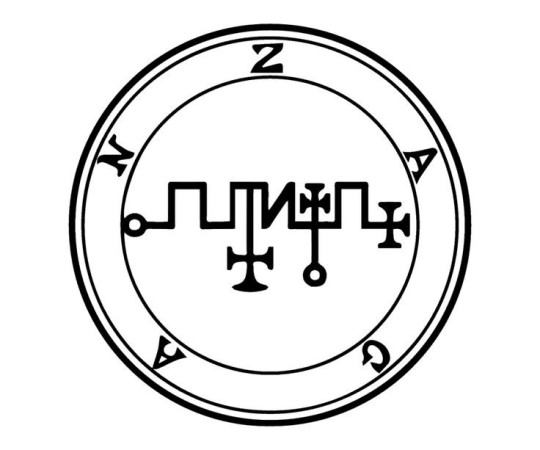
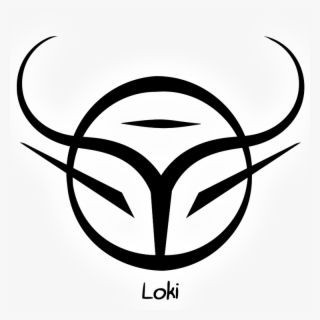
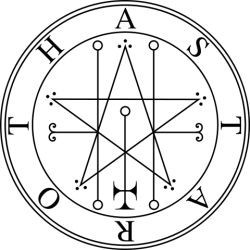
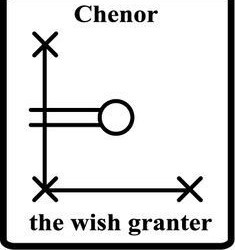
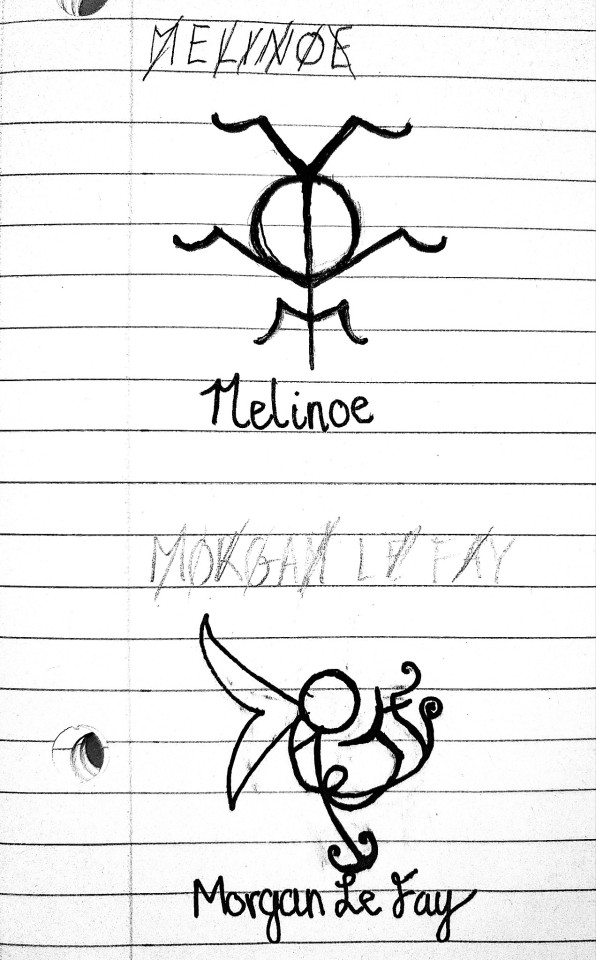
#magick#witch#witchcraft#sigil#sigils#sigil magic#sigil magick#chaos#chaos magick#chaos magic#chaos witch#satanic witch#lefthandpath#dark#satanism#demons#demonolatry#spirit work#spell work#spellwork#spell#spells#spellcasting#symbology#symbolism#symbols#eclectic#witchblr#witch community#pagan
650 notes
·
View notes
Text
Cassandra and the Nevarran Accent
and how it is a perfect recreation of the dead Gothic language
Accidentally discovered that Cassandra Pentaghast's accent matches up flawlessly with the extinct language of the Ostrogoths, and the Visigoths of pre-medieval Europe a few years ago and many of you wanted to see my notes so ive polished them up as much as I feel like and I am blessing you all with them now
I'll start by just going over the gothic language basics and then giving some good examples of Cassandra speaking, I am not a linguistics or etymology expert by any means, I am just a dumb ass who really likes ancient languages so bear with me, and ask questions if i make no sense
Gothic Language Basics
Phonetics-
Gothic does have very similar pronunciation to other Germanic languages with a few differences from it Frankish, and roman neighbors.
I am focusing on the basic and grammar and pronunciation as well as the phonetic alphabet, Gothic had a runic alphabet so there are a few letter without direct cognates and those will be spelled as they are pronounced for convenience
Rules - E, and O are always long, I is always short, A and U have both short an long variations EI digraph pronounced as long eye IU falling diphthong as in ew AI and AU digraphs each with numerous pronunciations
Short vowels - a, aí, i, aú, u Long - ā, ē, ai, ei, ō, au, ū Diphthongs - ái, áu, iu Consonants - b, g, d, kwa, z, h, th, k, l, m, n, ya/ja, p, r, s, t, w, f, x/ks, hw Significant Phonetics and Grammar
A lack of a short o sound, shift to an au sound instead
typical pronunciation of th, as well as V and W
light emphasis on the "hwh" sound of WH
Guttural sounds on vowels a, au, o ,u, and on consonants k, g, h
partly pitch, partly stress accent (think swedish as a very melodic example, german for a more stress based example)
no switching of the v and w pronunciation as seen in some west germanic languages
no rhotic r
no evidence of the Germanic umlaut
The way that i was going to have audio of her speaking here but tumblr is being a fucking menace so you will just have listen for yourselves, but pay close attention to how you will hear inconsistent pronunciation of the short o sound as in cot, no pronounced rhotic r's, proper th pronunciation, as well as her unique stresses on many other vowels
this isnt even to mention her hallmark guttural ugh sounds which are so unbelievably consistent with gothic it makes my heart sing
Some bonus Geographical Evidence if we look at the neighboring countries and languages at the time gothic was in use we see The roman empire - heavy use of greek and latin, the Franks - origins of the french language, the saxons -an ancestors of modern germans, the britons -ancestor of modern day britain and the empire of hispania - modern day spain these match up extremely well with nevarras neighboring countries being Orlais, The Anderfels, Tevinter, The Free Marches, even the way the Antiva is seperated from Nevarra by Tevinter matches the way The roman empire is positioned bewteen the goths and hispania The direct equivilents match up as Nevarra -The Goths Tevinter -The roman empire Antiva - Hispania Orlais - The Franks Ferelden/The Free Marches - Briton/Germanic States The Anderfels - Saxony Considering how much this geography influenced the gothic language its reasonable to assume Orlais, Tevinter, The Anderfels and The Free marches should have had similar effects on nevarran language.
maps for reference


Primary source was this Gothic Grammar Guide by Joseph Wright from 1910 that was based on the king james bible translation done by 4th century gothic priest Ulfilas
#this is as digestible as i can make this without going crazy#i am doing my best#i am not an academic#cassandra pentaghast#veilguard#nevarra#dragon age#emmrich volkarin#ingellvar#dragon age inquisition#dragon age the veilguard#linguistics#gothic#i dont know wtf to tag this
209 notes
·
View notes
Text
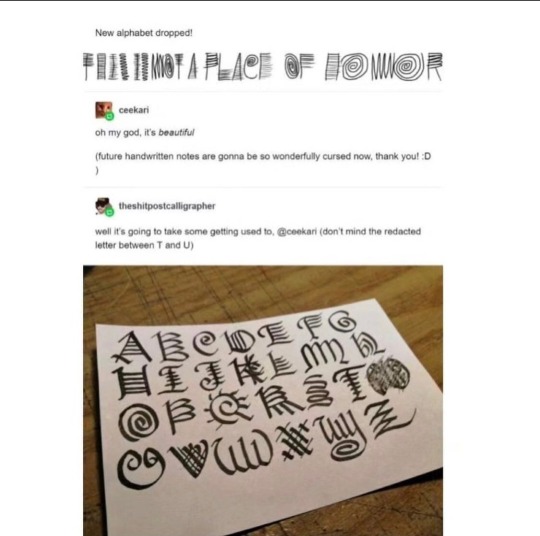
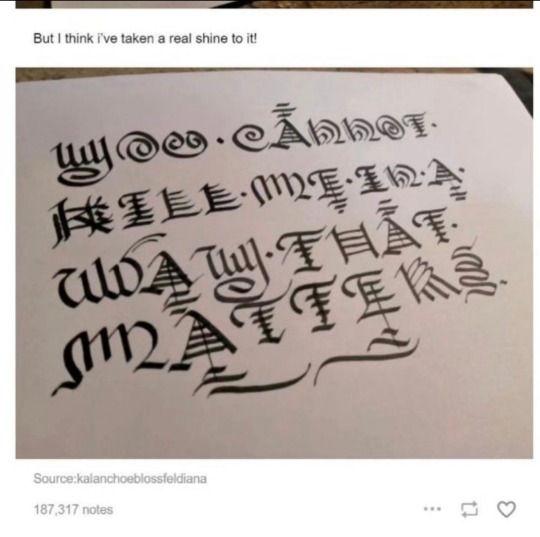
@theshitpostcalligrapher I'm sorry I can't find the thread to ask as a comment, but I need to know about the dots connoting the ends of each word. I've created a runic alphabet for a story I'm writing which has the same system with a symbol meaning a different word begins, and I would like to know if there was a calligraphic or historical context why you did it; seeing how a lot of your work seem to be medieval and gothic inspired.
836 notes
·
View notes
Note
could you, perhaps, talk a bit about Middle English? thank you, you're so cool
Writing Notes: Middle English
Middle English alphabet

The chronological boundaries of the Middle English period:
Not easy to define, and scholarly opinions vary.
The dates that OED3 has settled on are 1150-1500.
Before 1150 being the Old English period, and after 1500 being the early modern English period.
In terms of ‘external’ history, Middle English is framed at its beginning by the after-effects of the Norman Conquest of 1066, and at its end by the arrival in Britain of printing (in 1476) and by the important social and cultural impacts of the English Reformation (from the 1530s onwards) and of the ideas of the continental Renaissance.

Two very important linguistic developments characterize Middle English:
in grammar, English came to rely less on inflectional endings and more on word order to convey grammatical information. (If we put this in more technical terms, it became less ‘synthetic’ and more ‘analytic’.) Change was gradual, and has different outcomes in different regional varieties of Middle English, but the ultimate effects were huge: the grammar of English c.1500 was radically different from that of Old English. Grammatical gender was lost early in Middle English. The range of inflections, particularly in the noun, was reduced drastically (partly as a result of reduction of vowels in unstressed final syllables), as was the number of distinct paradigms: in most early Middle English texts most nouns have distinctive forms only for singular vs. plural, genitive, and occasional traces of the old dative in forms with final –e occurring after a preposition. In some other parts of the system some distinctions were more persistent, but by late Middle English the range of endings and their use among London writers shows relatively few differences from the sixteenth-century language of, for example, Shakespeare: probably the most prominent morphological difference from Shakespeare’s language is that verb plurals and infinitives still generally ended in –en (at least in writing).
in vocabulary, English became much more heterogeneous, showing many borrowings from French, Latin, and Scandinavian. Large-scale borrowing of new words often had serious consequences for the meanings and the stylistic register of those words which survived from Old English. Eventually, various new stylistic layers emerged in the lexicon, which could be employed for a variety of different purposes.
One other factor marks out the bulk of our Middle English evidence from the bulk of our Old English or early modern English evidence, although it is less directly a matter of change in the language than in how it is represented in writing:
the surviving Middle English material is dominated by regional variation, and by (sometimes extreme) variation in how the same underlying linguistic units are represented in writing.
This is not because people suddenly started using language in different ways in different places in the Middle English period, but because the fairly standardized late Old English literary variety broke down completely, and writing in English became fragmented, localized, and to a large extent, improvised.
Some Terminology
Great Vowel Shift - A systematic change in the long vowels in late Middle English that resulted in a new array of vowels, which includes diphthongs and tense vowels but which no longer generates a systematic distinction for length. Also called the Tudor Vowel Shift.
Lengthening - The change of a short vowel to a long vowel; it took place systematically during Middle English.
Levelling - The loss of distinctions in inflected endings, especially in early Middle English.
Thorn - A letter from the Germanic runic alphabet added to the Latin alphabet in Anglo-Saxon England to transcribe dental fricatives. It was used through the Middle English period and was gradually replaced by the sequence [th].
Wynn - A letter form adapted from the Germanic futhorc to indicate the sound [w] in the writing of Old English. It was used up to the Middle English period.
Yogh - A letter form used in Middle English and derived from the earlier insular letter form for [g]. In Middle English it was used for one of several consonant sounds.
Sources: 1 2 3 4 5 6 7 ⚜ More: Notes ⚜ Writing Resources PDFs
Some French Loans in Middle English Part 1 2
Some Renaissance & Latin Loan Words in Middle English
"Beautiful" Middle English Words
You are too sweet (I'm farthest away from the definition of "cool" haha). Do go through the links above for more details as well as an online Middle English dictionary. Hope this helps with your writing!
#anonymous#middle english#literature#writers on tumblr#writeblr#writing reference#dark academia#langblr#spilled ink#writing prompt#creative writing#writing inspiration#language#linguistics#history#writing resources
116 notes
·
View notes